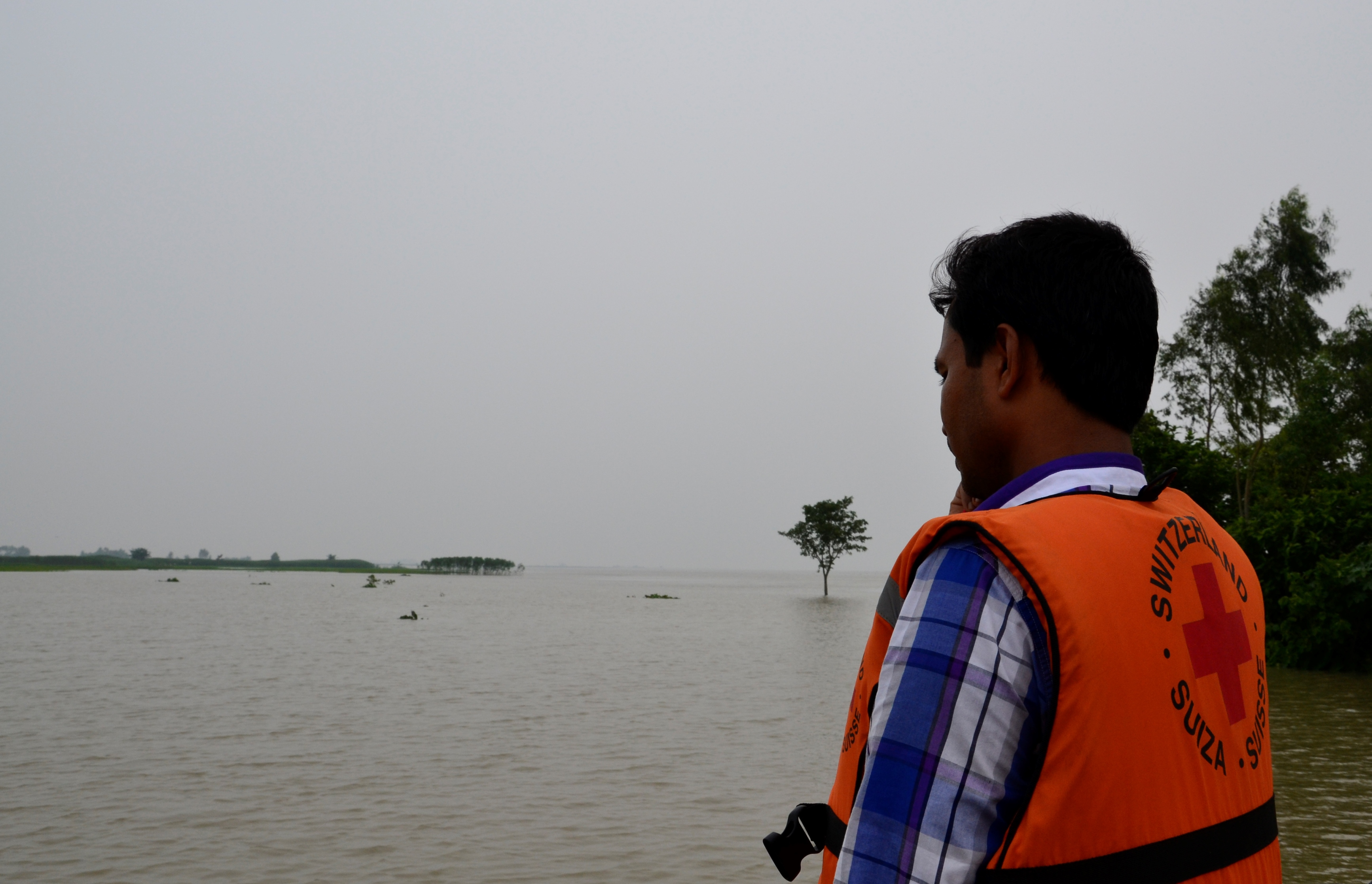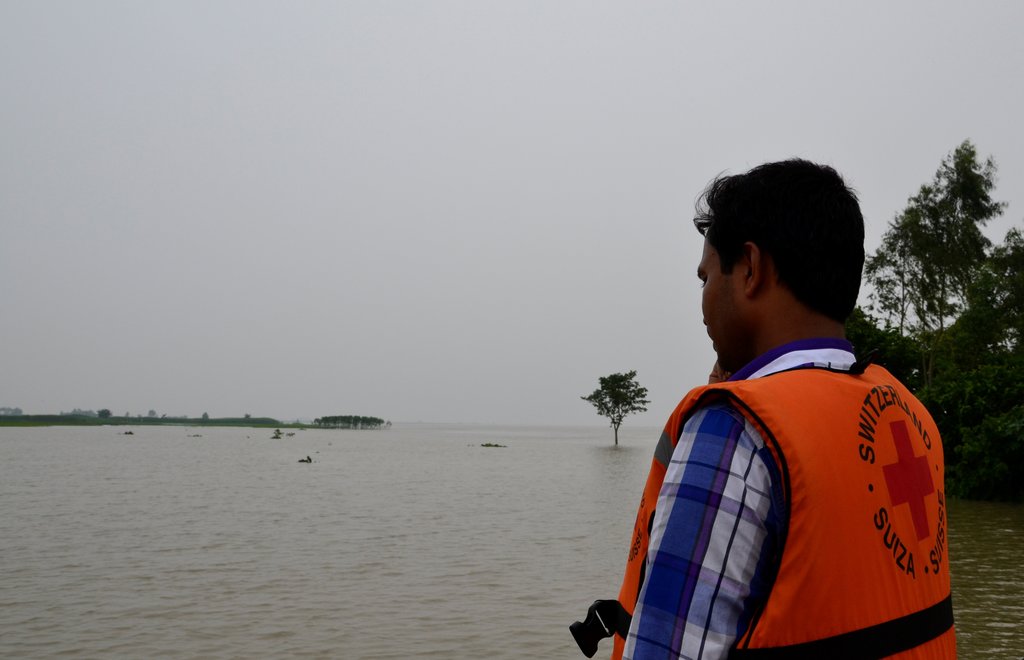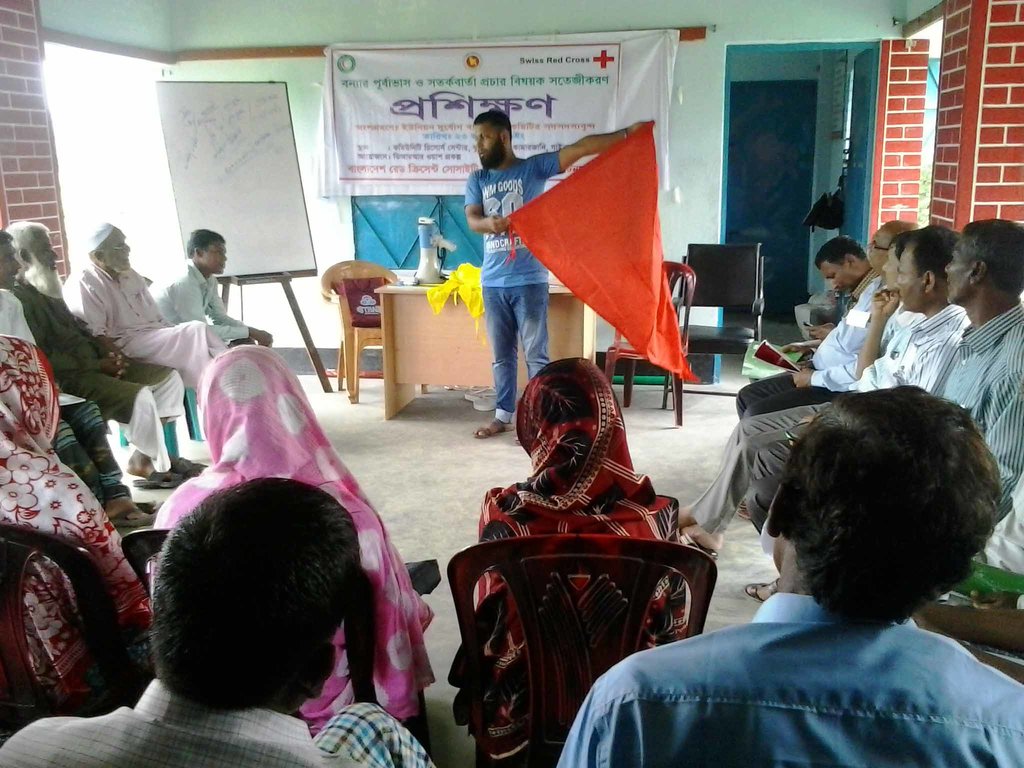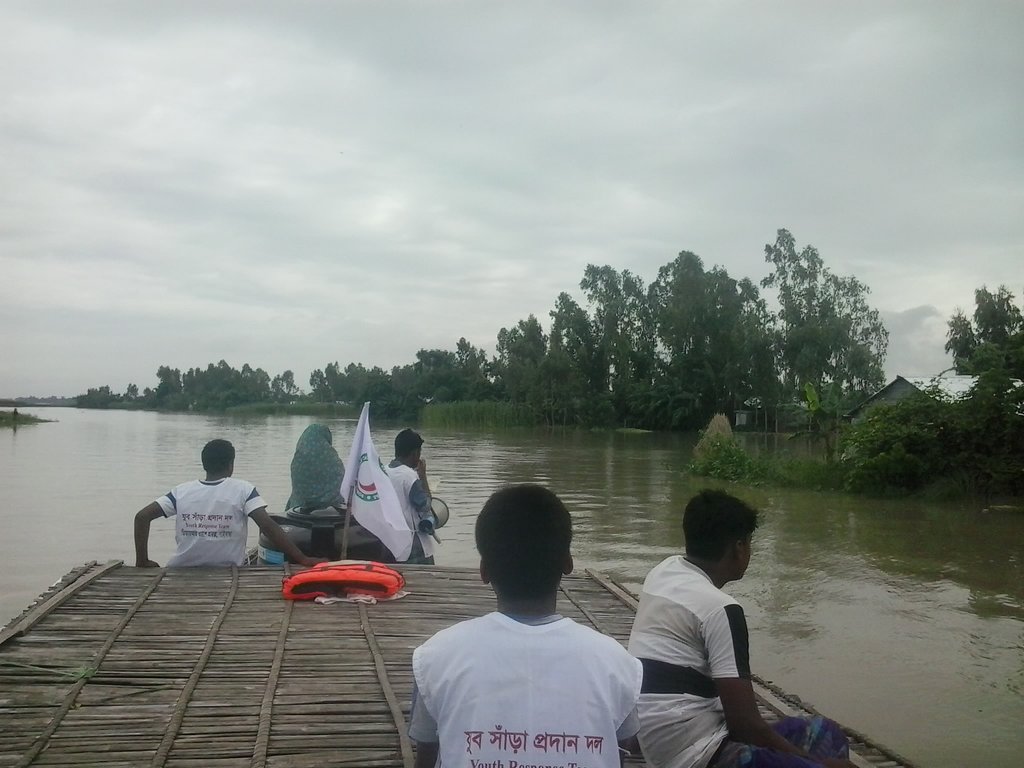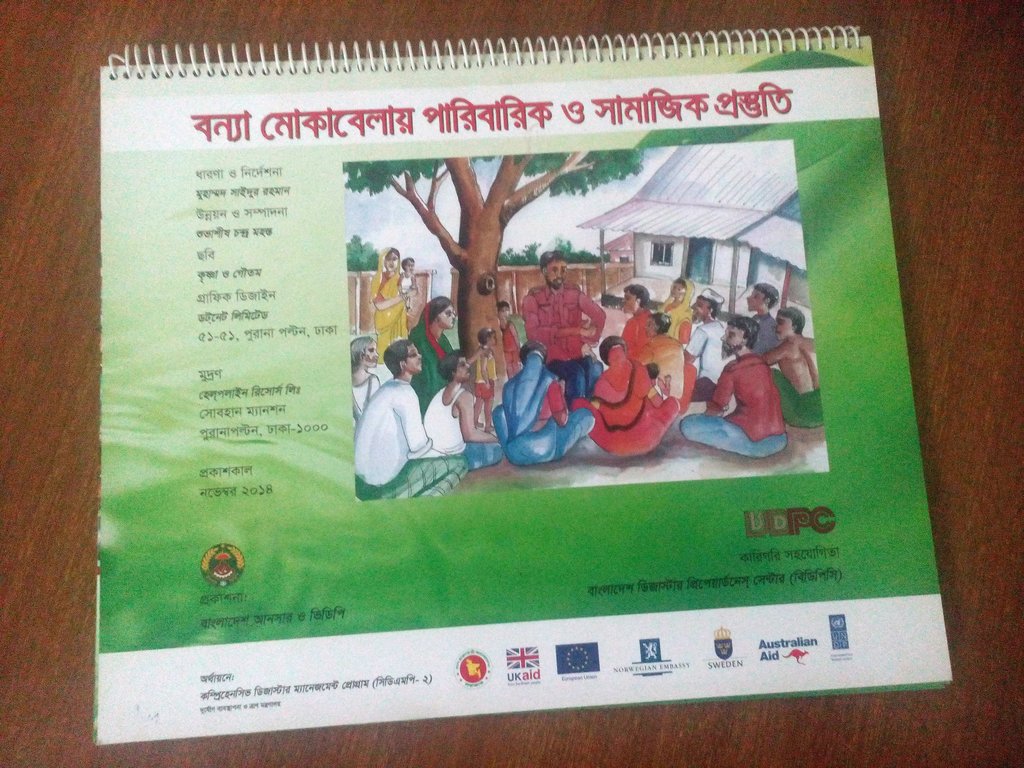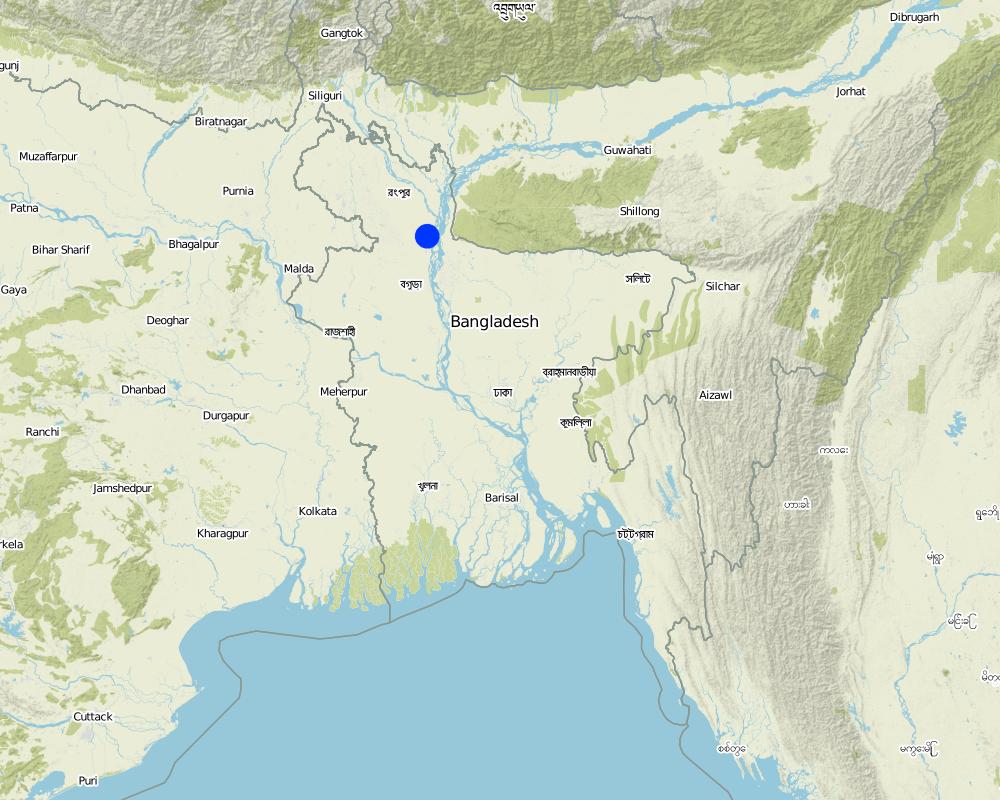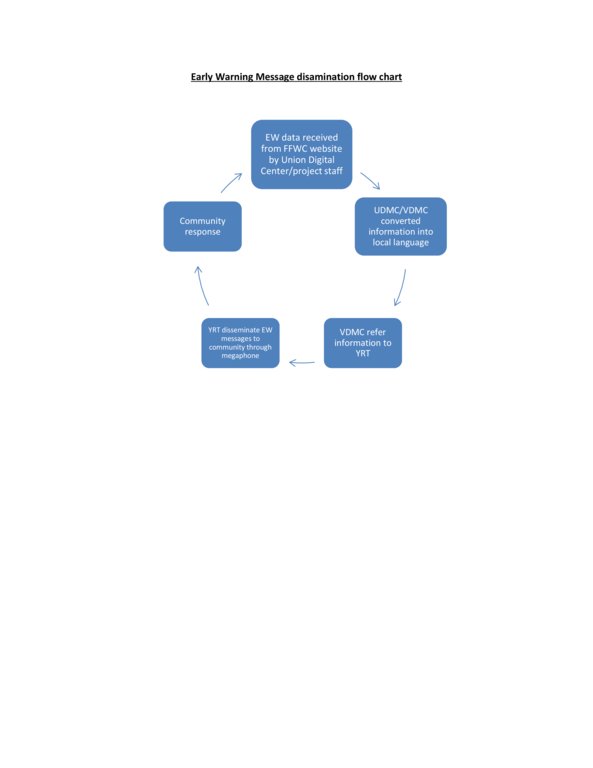Early Warning Message Dissemination [Bangladesh]
- Creación:
- Actualización:
- Compilador: TUHIN SAMADDAR
- Editor: Anton Jöhr
- Revisores: Alexandra Gavilano, Alvin Chandra
বন্যা পূর্ব-সতর্কবার্তা প্রচার (Bonna Purbo-Satarkabarta Prochar)
approaches_649 - Bangladesh
Visualizar secciones
Expandir todo Colapsar todos1. Información general
1.2 Detalles de contacto de las personas de referencia e instituciones involucradas en la evaluación y la documentación del Enfoque
Persona(s) de referencia clave/s
Project staff:
Mustafa Golam
+880 1718770373 / +880 1730799762
pmdrrwash16@gmail.com
Bangladesh Red Crescent Society
Project Manager, DRRWASH Project O⌀ਈce, Shukhsantir Bazar, Dhanghora, Gaibandha, Bangladesh
Bangladesh
Project staff:
Razzak Abdur
+880 1730 799763 / +880 1730 799763
razzak.pe@gmail.com
Bangladesh Red Crescent Society
Project Engineer, DRRWASH Project O⌀ਈce, Shukhsantir Bazar, Dhanghora, Gaibandha, Bangladesh
Bangladesh
Project staff:
Islam Saiful
+880 1730 799746 / +880 1730 799746
saiful644@gmail.com
Bangladesh Red Crescent Society
Field Officer DRR and Training, DRRWASH Project O⌀ਈce, Shukhsantir Bazar, Dhanghora, Gaibandha, Bangladesh
Bangladesh
Nombre del proyecto que facilitó la documentación/ evaluación del Enfoque (si fuera relevante)
Book project: where people and their land are safer - A Compendium of Good Practices in Disaster Risk Reduction (DRR) (where people and their land are safer)Nombre de la(s) institución(es) que facilitaron la documentación/ evaluación del Enfoque si fuera relevante)
Swiss Red Cross (Swiss Red Cross) - Suiza1.3 Condiciones referidas al uso de datos documentados mediante WOCAT
¿Cuándo se compilaron los datos (en el campo)?
04/10/2016
El compilador y la/s persona(s) de referencia claves aceptan las condiciones acerca del uso de los datos documentados mediante WOCAT :
Sí
1.4 Referencia/s al/los Cuestionario(s) de Tecnologías MST
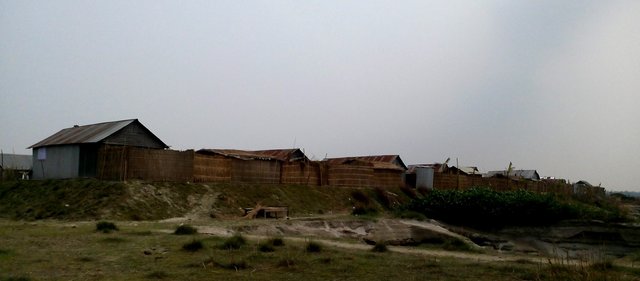
Emergency infrastructure including shelter and linked transport infrastructure [Bangladesh]
Emergency infrastructure including shelter and linked transport infrastructure, consists in establishing specific flood shelters (for people and animals) including flood-proof collective water sources and communication infrastructure as well as health and school facilities that may serve at the same time as emergency shelters during floods.
- Compilador: TUHIN SAMADDAR
2. Descripción del Enfoque MST
2.1 Breve descripción del Enfoque
An effective system for dissemination of early warning messages was established among the vulnerable communities in Chars (riverine sandy islands) of Gaibandha district, Bangladesh, in order to strengthen their coping mechanisms and reduce loss and damage caused by floods.
2.2 Descripción detallada del Enfoque MST
Descripción detallada del Enfoque MST:
Early warning systems are an essential element in building resilience through effective disaster preparedness and risk mitigation: the key characteristics of the approach entail linking the intervention units at community level with national and sub-national early warning systems. It also consists of developing the capacity of the local government institutions and organised communities to not only disseminate early warning but to effectively respond to floods. Merely installing an early warning system is not sufficient to equip communities to cope with recurrent floods; it needs to be linked to broader aspects of disaster preparedness and increased response capacity of communities and local government.
The vulnerability and capacity assessment (VCA) is the basis of all measures oriented at reducing disaster risks. The VCA was carried out with the involvement of local stakeholders, especially the target communities, to understand the vulnerabilities and risks associated with floods as well as to gain insight on existing capacities and capacity gaps that needed to be addressed. The process resulted in a risk reduction action plan which was to be jointly implemented by the target community and local government.
The risk reduction plan pointed to the need of having in place a mix of structural, management and contingency measures. This involved linking local, sub-national and national early warning systems, developing contingency and evacuation plans supported by establishment of safe places where people could move during floods. The risk reduction plan also highlighted the need to support household level protection measures - structurally this meant raising household plinth levels above flood levels. In addition, local early warning system was established through installation of flood markers/pillars, and warning flags at key sites. Capacities were built to internalise, monitor and consequently respond to evolving local flood situation.
Building communication channels that link the local institutions to higher level flood forecasting system resulted in streamlining information from source to destination. The weather forecast communication flow is both vertical and lateral – vertically it is a mix of web-based flood information and mobile telephony which begins at the Flood Forecast Warning Centre (FFWC) - the apex body that monitors flood situation in Bangladesh. FFWC transmits information to the sub-national local governments that have digital centres with trained personnel to access information from FFWC website. Trained entrepreneurs at these digital centres are responsible for monitoring flood forecasts and updating the Union Parishad (the lowest level of local body) and communities on evolving flood situation. By analysing and interpreting relevant information they play a key role in catalysing the early warning system. The local bodies , Union Parishads, use a mix of communication modes - such as miking (public address system), radio and cellular phone - to transfer early warning information to the communities. On the other hand, flood markers are installed locally that are adjusted according to increase in water levels. Designated trained persons – Youth Response Team - take the responsibility to do this. This is monitored by community and the Union Parishad.
In normal times, drills and simulations are conducted by trained team of village volunteers/first responders. They take the lead in organising evacuation and movement to safe places. The government (and project) brings in the logistic support, especially transportation, to facilitate evacuation and movement to safe places.
2.3 Fotos del Enfoque
Comentarios generales sobre las fotos:
Approach of Early Warning System in DRRWASH project area in Gaibandha district.
2.4 Videos del Enfoque
Comentarios, descripción breve:
Video on Flood 2015 in the DRRWASH project area in Gaibandha including early warning intervention, in Bangla, link:
https://www.youtube.com/watch?v=Os4ZgSMMVyg
Fecha:
25/10/2015
Lugar:
Gaibandha
Nombre del videógrafo:
Tuhin Samaddar and Vabotosh Karmakar
2.5 País/ región/ lugares donde el Enfoque fue aplicado
País:
Bangladesh
Región/ Estado/ Provincia:
North-Bengal
Especifique más el lugar :
Kamarjani and Mollar Char union in Sadar Upazila and Haldia union in Shaghata Upazila of Gaibandha District
Comentarios:
The entire intervention area is divided into 261 clusters. In each cluster, one local volunteer (YRT) has been nominated for preparedness and response operation. 30 Village Disaster Management Committee (VDMC) are actively monitoring the process under the guidance of three Union Disaster Management Committee (UDMC).
Map
×2.6 Fechas de inicio y conclusión del Enfoque
Indique año del inicio:
2013
Si no se conoce el año preciso, indique la fecha aproximada en la que se inició el Enfoque:
hace menos de 10 años (recientemente)
2.7 Tipo de Enfoque
- proyecto/ basado en un programa
2.8 Propósitos/ objetivos principales del Enfoque
To promote resilient communities through improved flood preparedness that reduces loss and damage of vulnerable people's lives and protects their livelihoods in the chars of Gaibandha district.
2.9 Condiciones que facilitan o impiden la implementación de la/s Tecnología/s aplicadas bajo el Enfoque
normas y valores sociales/ culturales/ religiosos
- facilitan
The intervention built upon traditional coping mechanisms and indigenous systems of disaster risk management. The blending of the traditional and indigenous practices with contemporary knowledge and preparedness practices acted as drivers in terms of choice and adoption of technologies.
- impiden
In earlier phases of the intervention, the cultural norm of not abandoning one's household even in extreme crisis hindered timely access to emergency infrastructure.
disponibilidad/ acceso a recursos y servicios financieros
- facilitan
The DRR intervention facilitated leveraging of institutional financial resources (Local government budget) and secured cost contribution from target communities.
- impiden
Lack of adequate capacities and resources with local government.
entorno institucional
- facilitan
The Disaster Management Act and Standing Orders on Disaster of the Govt. of Bangladesh provides for a decentralised disaster management institutional setting from the central level to the local level.
- impiden
In principle a decentralised disaster management structure is in place but due to operational and financial constraints they are unable to perform their mandated function.
colaboración/ coordinación de actores
- facilitan
The initiative built a good coordination with state actors at various levels. From time to time it was also able to secure collaboration from non-state actors around specific thematic areas such as obtaining livelihood support in non-farm sector, synergising disaster risk management work, ensuring access of vulnerable communities to social protection measures.
- impiden
Harmonisation of disaster centred initiatives is a time consuming process and very often does not lead to collaborations that harness existing synergies.
marco de trabajo legal (tenencia de tierra, derechos de uso de tierra y agua)
- facilitan
Disaster Management Act, 2012 provides the legal framework for disaster risk management in Bangladesh.
políticas
- facilitan
A set of policies supports the Disaster Management Act. Government's standing orders on disaster clearly defines the roles and responsibilities of various ministries, line agencies, local govt., mandated committees and other non-state actors in disaster risk management.
- impiden
Policy enforcement across sectors remains weak in Bangladesh.
gobernanza de tierras (toma de decisiones, implementación y aplicación)
- facilitan
Traditional rights to land are still accepted in Chars of Bangladesh .
- impiden
Land ownership is complex in Chars given its unstable nature due to high vulnerability to river erosion. Char lands are controlled by the local elites, often residing in the mainland, who use their political influence to secure govt. collusion/indifference (though char lands officially belong to them) in exercising land ownership and land transactions. Eventually it is the elites who lease and/or rent out land to the char population.
conocimiento de MST, acceso a apoyo técnico
- facilitan
Timely weather forecast allows communities to accordingly time their agricultural operation, especially the sowing operations
- impiden
River erosion threats strongly disincentivise investment in SLM.
mercados (para comprar insumos, vender productos) y precios
- impiden
Market forces are yet to develop properly in Chars which are by nature isolated geographical units, accessed only through time consuming and expensive transportation means.
carga de trabajo, disponibilidad de mano de obra
- facilitan
Higher productivity of land in Chars allow for lower labour engagement in agriculture.
- impiden
Disaster and higher profitability in mainland drives migration leading to labour shortages.
3. Participación y roles de las partes interesadas involucradas
3.1 Partes interesadas involucradas en el Enfoque y sus roles
- organizaciones comunitarias
Village Disaster Management Committee (VDMC)
The VDMC is the key actor to perform disaster risk reduction activities in the communities. The covers supporting the conduct of VCA, conducted by external facilitators, by extending logistic support and securing representative participation of larger community (non-VDMC members) in the VCA process. The VCA helps VDMCs develop their action plans. The operationalisation of the plans is anchored in the VDMC and so is leveraging cooperation and collaboration from local government. The VDMC also acts as first responder and as custodian responsible for operation and maintenance of built emergency and health infrastructure. Assessing community needs, beneficiary selection, contribution collection and financial management of hardware are their other key responsibilities.
Contribution collection means mediating and collecting the contribution of users/ beneficiaries and local governments to the costs of the built facilities (plinth raising, WASH, flood shelters, etc.) in pre-agreed proportion.
Financial management of hardware refers to VDMCs engaging in all aspects of the construction process of small scale communal and household mitigation options (flood shelters, roads, bridges, household plinth raising, etc. ) and shouldering financial management responsibilities related to their construction and subsequent operation and maintenance. This involves managing finances (contribution from users/LGI/project); giving work contract and settlement of payment following work completion.
- profesores/ niños en edad escolar/ estudiantes
Youth Response Team (YRT) members
YRT has been developed to promote volunteerism. Their main role is to support response and recovery operations during and after disaster. They are especially trained in Search & Rescue. As they are located in the community, YRTs actively engage in early warning dissemination. They act as focal person for monitoring and adjusting the flood markers. They support the Union Parishad in transmitting early warning to communities (as mentioned above) and supporting the evacuation of communities to safe places.
- sector privado
Enterpreneur of Union Digital Center
The lowest level of local government, the Union Parishad (UP), has a Digital Center to render ICT services to communities. These are run by local entrepreneurs. The entrepreneurs are responsible for monitoring flood forecasts on the internet and updating the Union Parishad (UP) and community-based organisations (CBOs) on evolving flood situation. By analysing and interpreting relevant information they play a key role in catalysing the early warning system.
- gobierno local
Union Disaster Management Committee (UDMC)
The UDMC disseminates forecasts, warnings, and advisories locally. It also performs a lead role in response and recovery operations.
Si varias partes interesadas estuvieron involucradas, indique la agencia principal:
UDMC
3.2 Involucramiento de los usuarios locales de tierras/ comunidades locales en las distintas fases del Enfoque
| Involucramiento de los usuarios locales de tierras/ comunidades locales | Especifique quién se involucró y describa las actividades | |
|---|---|---|
| iniciación/ motivación | interactivo | Key Actors: VDMC/CBOs and Local Government Institutions (UDMC) Activities : formation of CBOs, reformation of UDMC, VCA and volunteer selection |
| planificación | interactivo | Key Actors: VDMC/CBOs and Local Government Activities: preparation of risk reduction action plan, preparation of evacuation plan along with map of evacuation routes (route to be taken for the evacuation in moving to safe places), contingency plan development, planning of emergency and health infrastructure, Early Warning Systems (EWS) planning |
| implementación | interactivo | Key Actors: VDMC/CBOs and Local Government Activities: Establish Early Warning System, emergency infrastructure, access infrastructure (wooden bridge, roads, etc.), household infrastructure |
| monitoreo y evaluación | auto-movilización | Key Actors: VDMC/CBOs, Local and Sub-national Government Activities: Developing Quality Assurance System, Community Review Meeting, Site visits/physical verification, quality and financial audit, survey and spot checks, |
| Initiation | auto-movilización | Ket Actors: VDMC/CBOs, Local Government and Private Sector: Activities: O&M of built infrastructure and Sanitation Marketing which involves supporting local entrepreneurs to establish local supply chains of toilet building materials through their own investment and build toilets for users that bear the costs. The project does not build latrines directly but rather mediates the linkages of users with the sanitation entrepreneurs |
3.3 Flujograma (si estuviera disponible)
Descripción:
The flow chart explains application of the EWS and clarifies local linkages with national flood forecasting and warning centre (FFWC)
Autor:
Tuhin Samaddar
3.4 La toma de decisiones en la selección de Tecnología(s) MST
Especifique quién decidió la selección de las Tecnología/ Tecnologías a implementarse:
- todos los actores relevantes, como parte de un enfoque participativo
Explique:
Since participatory approach has been adopted to examine vulnerabilities and capacities, the approach and technology choice to address risk and vulnerabilities was collectively decided.
Especifique las bases que sustentaron la toma de decisiones:
- hallazgos de investigaciones
- la experiencia personal y opiniones (no documentadas)
- Government policies and mandates
4. Apoyo técnico, fortalecimiento institucional y gestión del conocimiento
4.1 Construcción de capacidades / capacitación
¿Se proporcionó la capacitación a usuarios de tierras/ otras partes interesadas?
Sí
Especifique quién fue capacitado:
- usuarios de tierras
- personal de campo/ consejeros
- Anser-VDP (Village Defence Party) member
Forma de capacitación:
- áreas de demostración
- reuniones públicas
- cursos
Temas avanzados:
Several training courses and workshops were organised on disaster preparedness and response:
1. Early Warning System (for UDMC/VDMC/ Anser-VDP/YRT/VCRP/Staff): Disaster context in Bangladesh, techniques to identify water levels against standardised danger levels, determining flood intensity by observing pillars and flags, dissemination strategies for early warning messages among the community, and role of stakeholders to warning message dissemination.
2. Evacuation Plan (for VDMC/YRT/VCRP): Response operation, preparing checklist for response, preparing risk and resource map, information collection and analysis, preparing evacuation route maps, and roles and responsibilities of respective stakeholders in effectuating evacuation plan
3. Response Plan (for UDMC): Importance of response plan, key constituents of preparedness and response, interpretation of Early Warning information from FFWC, creating contingency fund, search and rescue, emergency relief and first aid, identifying safe exit route and transportation, damage assessment, launching control room, involving existing manpower and resources in the community and other organisation, and prepositioning of rescue equipments.
Comentarios:
609 VDMC/UDMC members were trained on various DRR topics. 255 local youth volunteers (YRT/VCRP) were also trained on early warning message dissemination, flood forecast interpretation, preparing evacuation plan and route map.
4 mock drill demonstration events were conducted by local government in which 276 community members participated. Refresher training was also organised for newly elected union parishad members on their broad mandate with specific reference to their roles and responsibilities in disaster risk management.
4.2 Servicio de asesoría
¿Los usuarios de tierras tienen acceso a un servicio de asesoría?
Sí
4.3 Fortalecimiento institucional (desarrollo institucional)
¿Se establecieron o fortalecieron instituciones mediante el Enfoque?
- sí, mucho
Especifique el nivel o los niveles en los que se fortalecieron o establecieron las instituciones:
- local
- regional
Describa la institución, roles y responsabilidades, miembros, etc.
CBOs/Village Disaster Management Committee (VDMC)- on an average each CBO/VDMC has 17 members. Their roles and responsibilities entail assessments, beneficiary selection, developing and implementing Risk Reduction Action Plans (RRAPs) with special focus on disaster preparedness and response. A key function entails their engagement in Early Warning Systems (EWS) and planning and implementation of emergency and health infrastructure, shelter protection, and creating access infrastructure. Operation and Management of all built assets and infrastructure is their responsibility.
Local Government/UDMC: on average it has a 36 members. Standing orders on disaster of the government defines their roles and responsibilities which covers the entire gamut of functions associated with disaster risk management at the local level. Strengthening preparedness and leading effective response is critical to their mandate.
Especifique el tipo de apoyo:
- construcción de capacidades/ entrenamiento
- equipo
Proporcione detalles adicionales:
Megaphone, stretcher, Lifejacket, Lifebuoy, Torchlight, Raincoat, Gumboot, Rope and First aid box are some of the equipments that have been given to target communities. Further, the YRTs have received whistle, umbrella and apron for early response operation
4.4 Monitoreo y evaluación
¿El monitoreo y la evaluación forman parte del Enfoque?
Sí
Comentarios:
A joint monitoring team has been formed comprising representative of CBOs, local government and project staff.
Si respondió que sí, ¿la documentación se utilizará para monitoreo y evaluación?
No
4.5 Investigación
¿La investigación formó parte del Enfoque?
No
5. Financiamiento y apoyo material externo
5.1 Presupuesto anual para el componente MST del Enfoque
Indique el presupuesto anual para el componente del MST del Enfoque (en US$):
10384,00
Si no se conoce el presupuesto anual preciso, indique el rango:
- 10,000-100,000
Comentarios (ej. fuentes principales de financiamiento/ donantes principales):
Swiss Red Cross
Above mentioned amount is for the Early Warning System Implementation approach only
5.2 Apoyo financiero/material proporcionado a los usuarios de tierras
¿Los usuarios de tierras recibieron financiamiento/ apoyo material para implementar la Tecnología/ Tecnologías? :
Sí
5.3 Subsidios para insumos específicos (incluyendo mano de obra)
- ninguno
Si la mano de obra de usuarios de tierras fue un insumo sustancial, ¿fue:
- voluntario?
Comentarios:
All actions related to dissemination of early warning were performed on a voluntary basis.
5.4 Crédito
¿Se proporcionó crédito bajo el Enfoque para actividades MST?
No
5.5 Otros incentivos o instrumentos
¿Se usaron otros incentivos o instrumentos para promover la implementación de Tecnologías MST?
No
6. Análisis de impacto y comentarios de conclusión
6.1 Impactos del Enfoque
¿El Enfoque empoderó a los usuarios locales de tierras, mejoró el involucramiento de las partes interesadas?
- No
- Sí, un poco
- Sí, moderadamente
- Sí, mucho
The participation of all local stakeholders, especially women, has improved considerably.
¿El Enfoque facilitó la toma de decisiones basada en evidencia?
- No
- Sí, un poco
- Sí, moderadamente
- Sí, mucho
The decision making especially with regard to effectiveness and quality of approach and technologies has been determined by the evidence on the ground.
¿El Enfoque ayudó a los usuarios de tierras a implementar y mantener Tecnologías MST?
- No
- Sí, un poco
- Sí, moderadamente
- Sí, mucho
Since the implementation of technologies and maintenance of built infrastructure has been largely user led, it has improved their capacity to do the same.
¿El Enfoque movilizó/mejoró el acceso a recursos financieros para implementar MST?
- No
- Sí, un poco
- Sí, moderadamente
- Sí, mucho
User contribution and govt. contribution was a mandatory component of the project which led to mobilisation of resources that supplemented project resources.
¿El Enfoque mejoró el conocimiento y capacidades de otras partes interesadas?
- No
- Sí, un poco
- Sí, moderadamente
- Sí, mucho
Implementation of well designed capacity building plan cognizant of the needs of diverse stakeholders has improved the knowledge and capacities of relevant stakeholders.
¿El Enfoque construyó/ fortaleció instituciones, colaboración entre partes interesadas?
- No
- Sí, un poco
- Sí, moderadamente
- Sí, mucho
the central element of the approach has been to ensure sustainability of benefits which cannot be attained without strong institutions collaborating around disaster risk management work. Thus, the approach led to improved collaboration between stakeholders and strengthened institutions.
¿El Enfoque mitigó conflictos?
- No
- Sí, un poco
- Sí, moderadamente
- Sí, mucho
The approach is based on conflict sensitive programme management. This allowed for pro-active identification of conflicts and tensions followed by measures aimed at their mitigation.
¿El Enfoque empoderó a grupos en desventaja social y económica?
- No
- Sí, un poco
- Sí, moderadamente
- Sí, mucho
The extreme poor and socially disadvantaged were especially targeted by the disaster preparedness approach
¿El Enfoque mejoró la equidad de género y empoderó a las mujeres y niñas?
- No
- Sí, un poco
- Sí, moderadamente
- Sí, mucho
Though significant improvements are there as women and girls are much more aware about disaster preparedness in general and flood response in particular, there remains room for further improvement.
¿El Enfoque llevó a un acceso mejorado a tierra y saneamiento?
- No
- Sí, un poco
- Sí, moderadamente
- Sí, mucho
As part of strengthening preparedness to health hazards, water and sanitation infrastructure set up by the project has greatly improved access to water and sanitation
¿El Enfoque mejoró la capacidad de los usuarios de tierras a adaptarse a los cambios climáticos/ extemos y mitigar desastres relacionados al clima?
- No
- Sí, un poco
- Sí, moderadamente
- Sí, mucho
Strengthened DRM capacities include improved climate adaptation and capacities to mitigate climate induced disasters.
6.2 Motivación principal del usuario de la tierra para implementar MST
- reducción del riesgo de desastres naturales
Early warning system helps people prepare and act before the water level crosses danger level (which denotes the settlement is at risk of inundation)
6.3 Sostenibilidad de las actividades del Enfoque
¿Pueden los usuarios de tierras sostener lo que se implementó mediante el Enfoque (sin apoyo externo)?
- sí
Si respondió que sí, describa cómo:
Union Digital Center is an information hub that exists in the union where people have easy access. The technology is simple and the approach is easy to understand and has already benefited the targeted community. The anchoring of preparedness in general and Early Warning Systems (EWS) in particular in local government and its rolling out in collaboration with communities imparts high probability of sustainability to disaster preparedness measures. During the project cycle, two flood events of significant magnitude have tested the approach and technology and resulted in tangible benefits for the community. At the same time since sustainability considerations are inbuilt in project design and have guided the implementation of the approach and technology, the likelihood of their sustainability is very strong.
6.4 Fortalezas/ ventajas del Enfoque
| Fuerzas/ ventajas/ oportunidades desde la perspectiva del usuario de la tierra |
|---|
| A trained group of volunteer is available in the community |
| Response equipments are in place and ready to use if and when needed |
| Early Warning System facilitates people's timely access and movement to appropriate emergency infrastructure and protected shelters |
| Rapid evacuation, especially for physically challenged, children and elderly people, and cattle |
| Crops are saved due to timely action related to sowing and harvesting |
| Means of preparedness, such as boat, banana raft, portable cooker, firewood, oral rehydration solution, dry food can be collected beforehand |
|
Balanced representation of community in governmentt mandated disaster committees |
| Coordination/ communication with development actors and local government/union parishad is more forthcoming |
| Fuerzas/ ventajas/ oportunidades desde la perspectiva del compilador o de otra persona de referencia clave |
|---|
| Sustainability dimensions have been well considered and applied in adopted approach and technologies |
| Strengthened community institutions are in place to address disaster risk Management issues, especially those related preparedness and response mechanisms |
| Community and local government interface has been strengthened to devise appropriate disaster Management solutions |
| Decisions on preparedness approach and attendant technologies are taken collectively by stakeholders |
| A replicable model of early warning systems, emergency and access infrastructure has been established |
6.5 Debilidades/ desventajas del Enfoque y formas de sobreponerse a ellos
| Debilidades/ desventajas/ riesgos desde la perspectiva del usuario de la tierra | ¿Cómo sobreponerse a ellas? |
|---|---|
| Long term maintenance of response equipments | UDMC should play custodian's role; local people should contribute towards recurrent cost |
| Debilidades/ desventajas/ riesgos desde la perspectiva del compilador o de otra persona de referencia clave | ¿Cómo sobreponerse a ellas? |
|---|---|
| Replicability of the model might be difficult due to lack of funds and functionaries available with local government | Support local government in negotiating more resources from higher levels of governance and Administration; build capacity of local government to utilise resources efficiently and effectively |
7. Referencias y vínculos
7.1 Métodos/ fuentes de información
- entrevistas con usuarios de tierras
15 Key Informant Interview (KII)
2 Focus Group Discussion (FGD)
- entrevistas con especialistas/ expertos en MST
4
- compilación de informes y otra documentación existente
6
7.2 Referencias a publicaciones disponibles
Título, autor, año, ISBN:
Three VCA Reports published by UDMC with support of DRRWASH project
¿Dónde se halla disponible? ¿Costo?
Bangladesh Red Crescent Society
7.3 Vínculos a la información relevante disponible en línea
Título/ descripción:
Flood Forecasting & Warning Centre (FFWC), Bangladesh Water Development Board (BWDB), SOD
URL:
http://www.ffwc.gov.bd/#, http://ddm.portal.gov.bd/sites/default/files/files/ddm.portal.gov.bd/page/a3f4cc27_7f7d_4c2b_a1b0_166fe6bef73b/udmc.pdf
Vínculos y módulos
Expandir todo Colapsar todosVínculos

Emergency infrastructure including shelter and linked transport infrastructure [Bangladesh]
Emergency infrastructure including shelter and linked transport infrastructure, consists in establishing specific flood shelters (for people and animals) including flood-proof collective water sources and communication infrastructure as well as health and school facilities that may serve at the same time as emergency shelters during floods.
- Compilador: TUHIN SAMADDAR
Módulos
No se hallaron módulos


